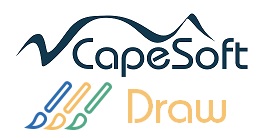

| Equate | Description |
|---|---|
| DrawLinkMode | Set to 1 if this project will compile the classes, or 0 if the classes are exported into this project via a LIB file. |
| DrawDLLMode | Typically the inverse of the setting above. Set to 1 is the class is in another DLL, 0 if local to this project. |
| DrawImage | Set to 1 if the object will make use of the WritePNG method (or any other method that requires FreeImage) |
| DrawGuage Methods | |
|---|---|
| GenerateImage | Sets a Draw object to a QR Code image. |
| GenerateIntoImage | Injects a QR Image into a Draw object, at a specific position. |
| GenerateText | Generates a Text form of a QR Code. In other words the result
of this is a String, not an image. |
| GetSize | Returns the size of the QR Code for a specific set of text. |
| Init | Called to initialize the object to the Image control on the window. |
| Start | Called before you start using the object. This restores the object to "clean" initial settings, especially useful if you are reusing the object to display a completely QRCode. |
| Useful Inherited Methods | |
| ToClipboard | Copy the contents of the image to the clipboard. Suitable for then pasting in Word, or Paint, or wherever images can be pasted. |
| WriteBMP |
Save the image to the disk as a BMP file. |
| WritePNG | Save the image to the disk as a PNG file. |
| Parameter | Description |
|---|---|
| pText | The text to encode. |
| Parameter | Description |
|---|---|
| pText | The text to encode. |
| pXpos | The x position to place the QR code. |
| pYpos | The y position to place the QR code. |
| Parameter | Description |
|---|---|
| pText | The text to encode. |
| Parameter | Description |
|---|---|
| pText | The text to encode. |
| Parameter | Description |
|---|---|
| Control | The use equate of an image control on the window. |
| pReport | If the QR Code is on a report, then put the report structure in here. If you do this then you don't need to call SetTarget before calling GenerateImage. |
| Properties | ||
|---|---|---|
| AutoDisplay | Byte | Set to true if the image should automatically call DISPLAY when being generated. Default is true. If set to false a manual call to ThisQR.Display() will be needed to transfr the image to the screen. |
| AutoResize | Byte | If this is set to true then the control on the window will be resized to fit the image, at the specified pix per box. If set to false then the image is centered, or stretched (or tiled) depending on the Image control properties. |
| BackgroundColor | Long | The QRCode will be cleared to this color before drawing. (This basically means this becomes the border color.) |
| Border | Byte | The size of the border around the QR Code. This defaults to 0. |
| Char | String(1) | When creating Text QR Codes, this is the character used for the "black" square. Defaults to 'X'. |
| Color1 | Long | The colors used in the QR Code itself. Default values are Black and White. |
| Color2 | Long | |
| Ecc | Byte | The Error Correction value to include in the QR Code. Higher
values result in bigger QR Codes, but are more tolerant of
scanning errors. The default value is QR_Ecc_QUARTILE.
The possible options are; QR_Ecc_LOW Equate(0) ! The QR Code can tolerate about 7% erroneous codewords QR_Ecc_MEDIUM Equate(1) ! The QR Code can tolerate about 15% erroneous codewords QR_Ecc_QUARTILE Equate(2) ! The QR Code can tolerate about 25% erroneous codewords QR_Ecc_HIGH Equate(3) ! The QR Code can tolerate about 30% erroneous codewords |
| Max | Byte | The maximum size of the QR Code. (This is known as "version" in the QR world, but is not like a code "version".) The engine supports a size up to 40, which is in accordance with the QR Specification. Defaults to 40. |
| Min | Byte | The minimum size of the QR Code. The engine supports a size down to 1, which is in accordance with the QR Specification. Defaults to 1. The actual size of the resultant QR code depends on the amount of information in the text. |
| Mode | Long | QR Codes can be generated in different modes. This has an
impact on the size of the image. For example knowing that a code
contains only numbers allows the QR code to be smaller. The
possible options are; QR_Mode_AUTO Equate(-1) QR_Mode_NUMERIC Equate(1) QR_Mode_ALPHANUMERIC Equate(2) QR_Mode_BYTE Equate(4) The default is QR_Mode_AUTO |
| Pix | Byte | The number of pixels per 'square' in the resultant QR Code.
The default value is 5. |
| Size | Byte | The size of the QR code, as generated by the engine. You can
inspect this property after generating the QR Code to determine
the size of the code. This is the size in "boxes" (also known as
the QR Version) - so to get the pixel size multiple by pix, and
add the border twice. |